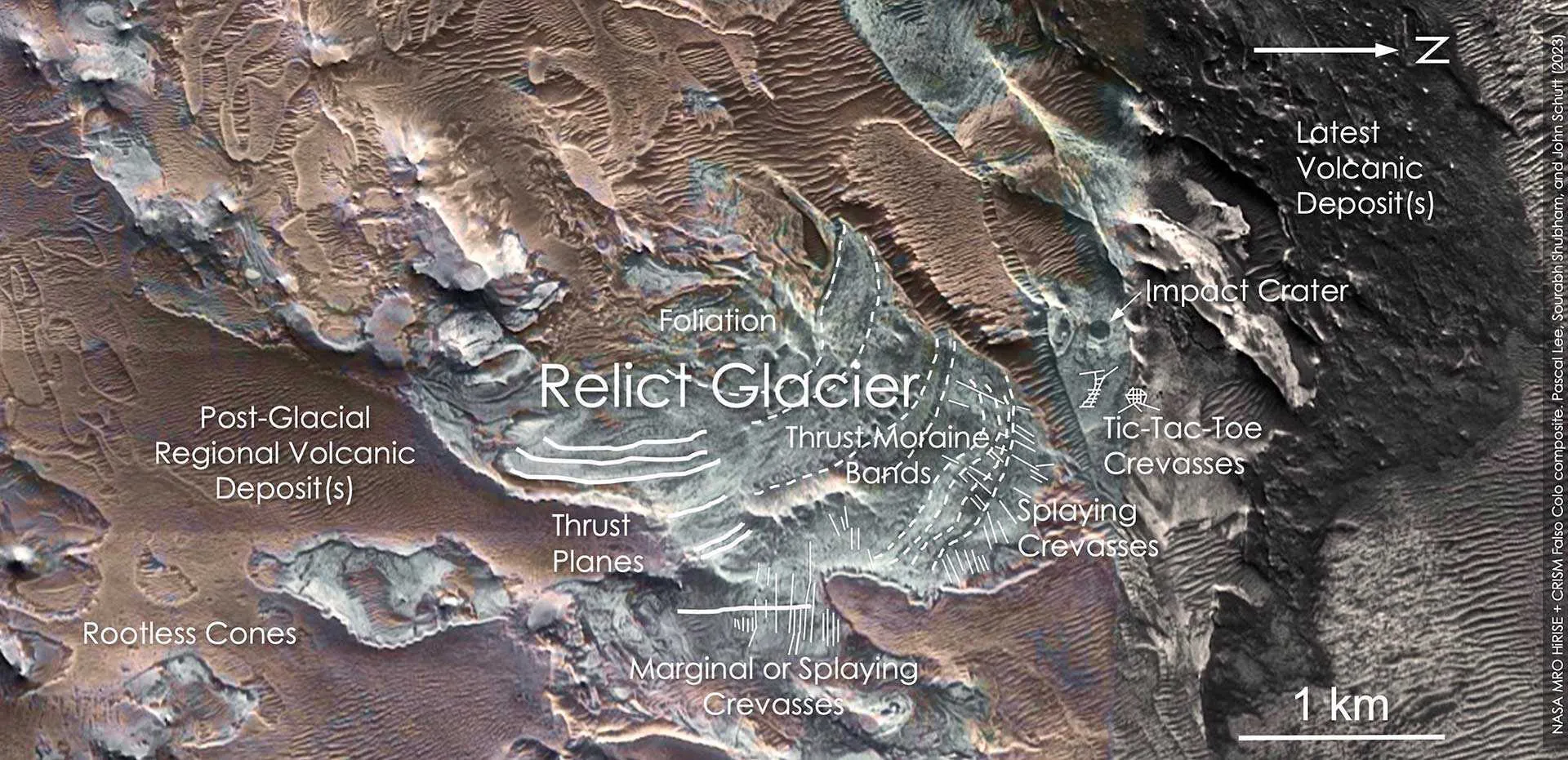- March 30, 2023
- By Georgia Jiang
The remains of a glacier near Mars’ equator shows the planet’s relatively recent history may have been more watery than previously thought, and thus more capable of sustaining life.
According to the team that discovered it, which includes University of Maryland geology doctoral student Sourabh Shubham, this discovery has significant implications for understanding Mars’ past and present habitability, and could help guide future human exploration of the planet. The researchers announced their findings this month at the 54th Lunar and Planetary Science Conference in Houston.
These remains are not ice, but a large surface deposit of light-colored sulfate salts with the detailed morphologic features of a glacier, said the study’s lead researcher, Pascal Lee, a planetary scientist with the SETI Institute and the Mars Institute. “What we think happened here is that salt formed on top of a glacier while preserving the shape of the ice below, down to details like crevasse fields and moraine bands,” Lee said.
The remains of the Mars glacier are at least 4 miles long and up to 2.5 miles wide. Shubham, who conducted the remote sensing analyses to support the study’s findings, helped the scientists determine the composition of the salts and figure out how they might have accumulated in the first place.
“This region of Mars has a history of volcanic activity,” Shubham said. “And where some of the freshly erupted volcanic materials—like ash, pumice and hot lava blocks—came in contact with glacier ice, chemical reactions would have taken place at the boundary between the two, resulting in a hardened layer of sulfate salts.”
Over time, as those volcanic materials eroded away, it revealed a crusty layer of sulfates mirroring the glacier ice underneath, including certain features unique to glaciers, such as crevasses and moraine bands (strips of rock and soil debris transported by moving ice).
The team further observed that the glacier’s fine-scale surface features were also sparsely cratered by impacts—indicating that the glacier is likely to be relatively young, geologically speaking. As a rule of thumb, older surfaces have been exposed to impacting celestial bodies like asteroids and comets for a much longer amount of time than younger surfaces, which explains why older surfaces tend to have more impact craters.
“Our team estimates that the original glacier is likely Amazonian in age, the latest geologic period which includes modern Mars,” Shubham explained.
For the team, this was an especially surprising discovery; scientists have known about glacial activity on Mars at many different locations and at higher latitudes, but the relatively young remnants of this glacier indicate that Mars experienced surface ice in recent times even near its equator, generally the planet’s warmest location.
Further studies may show whether water ice is still preserved beneath the light-toned deposit or if it has disappeared entirely. Currently, water cannot exist in solid or liquid form on the surface of Mars near the equator at this elevation, as Mars’ low atmospheric pressure and temperature would cause water to sublimate (evaporate from ice to gas directly, skipping the liquid phase). However, the team believes it’s possible that some water ice might still be present under the sulfate salts.
Ultimately, if water ice is still preserved at shallow depths near Mars’ equator and similarly low latitudes of the planet, it could have significant implications for future research and human exploration.
“The desire to land humans at a location where they might be able to extract water ice from the ground has been pushing mission planners to consider higher latitude sites, but the latter environments are typically colder and more challenging for humans and robots,” Lee explained. “If there were equatorial locations where ice might be found at shallow depth, then we’d have the best of both environments: warmer conditions for human exploration and still access to ice.”

